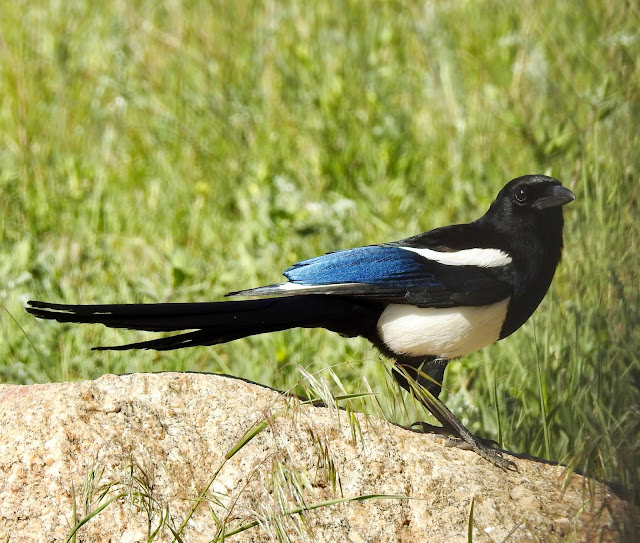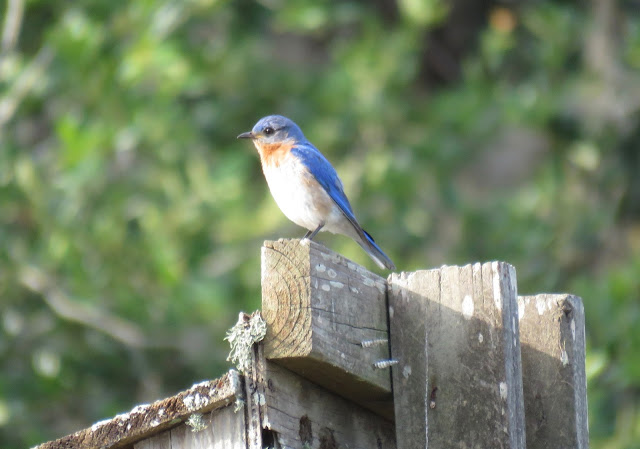May is a split-personality month for birders. It starts with the excitement of migration which begins in April but often peaks in early May. On the other hand, the month ends with the heat of summer and a bird population comprised chiefly of the usual suspects -- 12-month and summer-only residents. The migrants that cause the fevered-pitch birding of April and early May are gone.
In Gainesville, April and May were hot and as dry as tinder. Seemingly endless sunny days offered picture postcard promises, but the lack of rain created a drought of almost historic proportions, and much of the landscape turned brown. Lake levels dropped and only drought-tolerant plants really thrived.
My friend Rex Rowan and I started the month with a walk along the Lake Pithlachocco Trail in the Newnan's Lake State Forest. We had a great morning with about 30 species, highlighted by a Cape May Warbler in a wild plum tree. But my favorite sighting happened when I noticed something dart high into a tree above my head. We searched for the bird and found more than we were expecting. It was a Ruby-throated Hummingbird's nest.
We had about 30 species during the morning, including a Cape May Warbler in a wild plum tree and another in some grapevines, but seeing this lovely lady working on the nest felt more like I had been given a rare privilege.
It was a promising start to the month, but the rest of the month was disappointing in some ways. It seemed that field trips were much less successful than watching feeders in the back yard. Early May can surprise and delight with rare feeder visitors like this Rose-breasted Grosbeak.
Northern Parulas are in their best plumage in May, with fresh, vibrant colors adorning their throats and breasts.
Even the local crowd is breaking out their fresh plumage and putting on a show. This Red-bellied Woodpecker was sporting the crimson patch on his belly that gave the species its name.
Of course, much of the bird activity disappears when a Red-shouldered Hawk decides to take a bath.
Still, it's the migrants we're really looking for, and this beautiful female Painted Bunting added quite a thrill. She showed up on May 7 and hung around for a couple of days.
Occasionally Alachua Audubon offers a field trip to the Jacksonville area that typically begins at Huguenot Memorial Park. I look forward to this trip a lot. I love the opportunity to study shorebirds and large numbers of gulls and terns. This year, however, the morning was marked by driving winds that urged the birds into cover and whipped the sand into an abrasive cloud that lashed us unmercifully while we trudged along the beach. I couldn't hold the camera steady at all, a sand found its way into my ears (sneaking past my hearing as!) and even into my mouth. Every time I tried to speak, sand crunched between my teeth. Early in I got this distant photo of a Black-bellied Plover.
A few hours later I saw some Royal Terns doing their best to ignore the wind while ensuring the survival of their species.
The conditions improved significantly once we left the coast and focused on several spots on Fort George Island. Unfortunately, photography continued to be a challenge. Only the larger birds seemed to venture out into the open. While not a "countable" bird, I appreciated the peacock's willingness to pose for pictures.
A week later I led a field trip to Alligator Lake in Lake City. Fortunately, we proved we could have lots of fun without lots of birds. We only had about 25 species, a very low number for such a great environment. This Eastern Bluebird perched up early on the trail, but it was one of the very few birds to do so all morning.
In fact, I spent time photographing a Zebra Longwing butterfly on some lantana ... a sure sign of a bored birder.
Meanwhile, three of my friends were using their great cameras to photograph a Wood Duck way out on the lake. I had to settle for photographing them:
 |
| Tina, Jerry, and Stephanie, good birders, photographers and friends. |
|
Meanwhile, back at the feeders ...
 |
| Blue Grosbeak |
The combination of the sand blasting at Huguenot Park and a rugged life on the birding trail had taken a toll on my Canon camera. I enjoyed it a lot, and took many really good photos. But now it had started doing some odd things at inopportune moments. I did some internet research and talked to some friends before finally settling on a Nikon Coolpix P900. Of course, as soon as I got it, I had to start snapping away, whether there were birds anywhere nearby or not.
 |
| Mimosa after an early morning rain. |
Then I tried shots at distances I could not have tried with my old camera.
 |
| White-winged Dove in the back of a yard, well away from where I stood. Could not have done it before. |
 |
| Red-shouldered Hawk across a long lawn and up on the wires. Could not have done it before. |
And then there were details I didn't capture before.
 |
| House Finch eating Nutrasaff from Wild Birds Unlimited. |
 |
| Red-bellied Woodpecker sunning himself on a branch above my feeders. |
 |
| Great Crested Flycatcher, one of my favorite birds of summer. |
 |
| Pileated Woodpecker. This one was looking for a dip in a drip pool. |
Of course, spring migration and fresh plumages are all about the annual ritual of mating, nesting, and raising young. And this month held true to form. May ended with a welcome sight, a young Eastern Bluebird, still sporting its juvenile plumage.
April had ended with my 2017 Alachua County total standing at 141 and my Florida total at 197. Despite the promise of more migrants in May, a variety of factors outside my control had really limited my birding success. For the month I had only 45 species within the county (my lowest total in over a decade), and a total of 80 within the state (another all-time low). Accordingly, my county total for the year inched upward by only two to 143, while my state total increased to 203.
While May was disappointing, June was certain to be very special. The June Challenge was about to begin, and I had a trip out west that I know you'll want to hear about.





















































